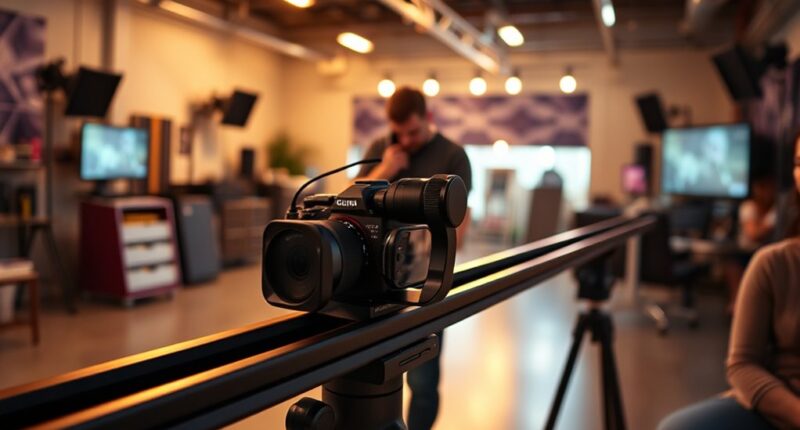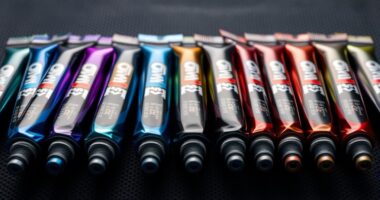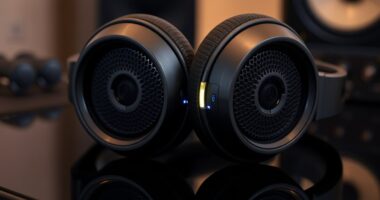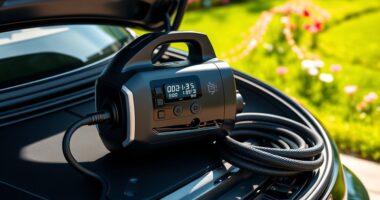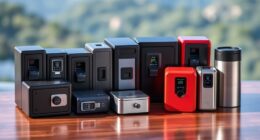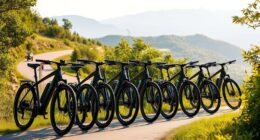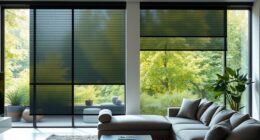If you’re after the best motorized camera sliders for smooth shots in 2025, I recommend considering models with versatile features like app control, dual operation, and sturdy construction. Options like GVM’s 27” aluminum alloy slider or Neewer’s versatile models offer excellent stability, multiple modes, and portability for various filming needs. Pay attention to power options, noise levels, and control precision. Keep exploring, and you’ll discover the perfect slider that matches your style and budget.
Key Takeaways
- Features diverse shooting modes like time-lapse, panoramic, and tracking for versatile cinematic shots.
- Built with durable, lightweight materials such as carbon fiber and aluminum for outdoor portability.
- Offer multiple control options, including smartphone apps, remote controls, and manual knobs for precise adjustments.
- Support extended battery life and quiet operation suitable for professional videography and live recording.
- Designed with portability and compatibility in mind, fitting various devices and accessories for creative flexibility.
GVM Camera Slider, 27” Aluminum Alloy Motorized Slider
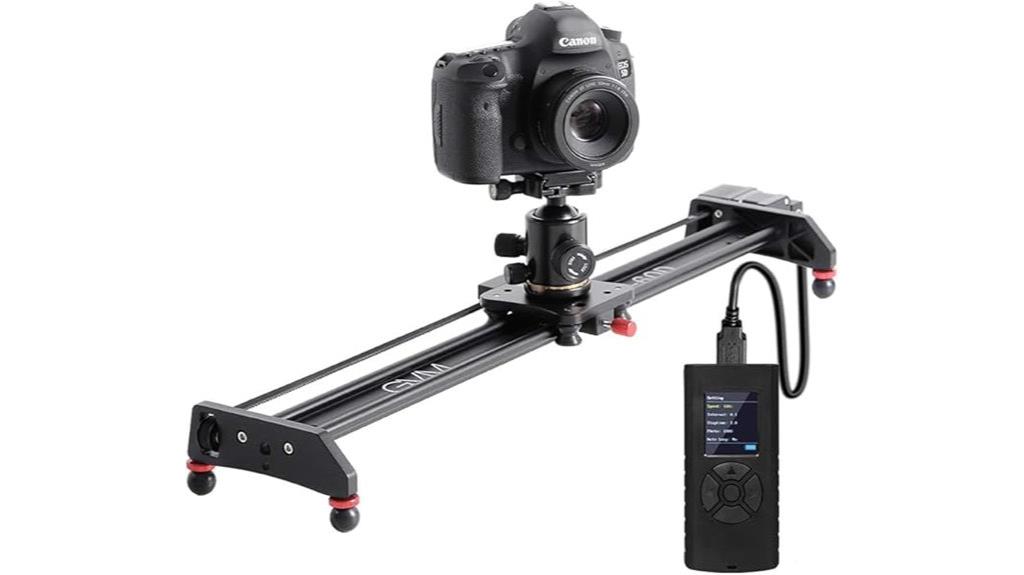
If you’re looking for an affordable yet reliable motorized slider that offers versatile shooting options, the GVM Camera Slider, 27” Aluminum Alloy Motorized Slider is an excellent choice. I’ve found it supports time-lapse, video, and round-trip shooting with adjustable slip speed and interval, making it flexible for different projects. It’s compatible with DSLRs, smartphones, and various camera brands like Sony, Canon, and Nikon. Its durable aluminum construction, combined with a compact size and 5.5 lbs weight, makes it portable yet sturdy. Plus, the multi-angle shooting and adjustable feet help stabilize shots on different surfaces, enhancing your creative options.
Best For: hobbyists, freelancers, and professionals seeking an affordable, versatile, and portable motorized slider for time-lapse, video, and creative shooting projects.
Pros:
- Supports multiple shooting modes including time-lapse and round-trip with customizable settings
- Durable aluminum alloy construction with lightweight portability at around 5.5 lbs
- Compatible with a wide range of cameras and accessories, offering multi-angle shooting options
Cons:
- Motor noise may interfere with live audio recording during operation
- Some users experience belt slack or carriage play requiring manual adjustments
- Remote control’s plastic parts can be fragile, and some components may be prone to defects over time
NEEWER Motorized Camera Slider (ER1-80)

The NEEWER ER1-80 motorized camera slider stands out as an excellent choice for videographers seeking a portable and versatile solution. At 31.5 inches long, it’s made from lightweight yet sturdy carbon fiber, supporting up to 11 pounds horizontally and 5.5 pounds at 45°. It features a quiet stepper motor, a 2600mAh battery, and multiple control options via app or remote, supporting modes like manual, video, and time-lapse. Its adjustable knobs enable various angles, including tracking shots and panoramas. Weighing just 5.5 pounds, it’s easy to set up and transport. While some users report minor wobbling or connectivity issues, overall, it offers smooth, reliable motion perfect for creative projects.
Best For: videographers and content creators seeking a portable, versatile motorized slider for smooth cinematic shots, timelapses, and creative angles.
Pros:
- Lightweight and sturdy carbon fiber construction for portability and durability
- Multiple control options including app and remote, with versatile shooting modes
- Adjustable knobs allow for a variety of angles and creative shot types
Cons:
- Occasional wobbling or jittery footage when used with heavier gear or manual operation
- Connectivity issues with the app or remote can affect control stability
- Smaller mounting plate may require additional adapters for certain cameras
NEEWER Motorized Camera Slider with App Control
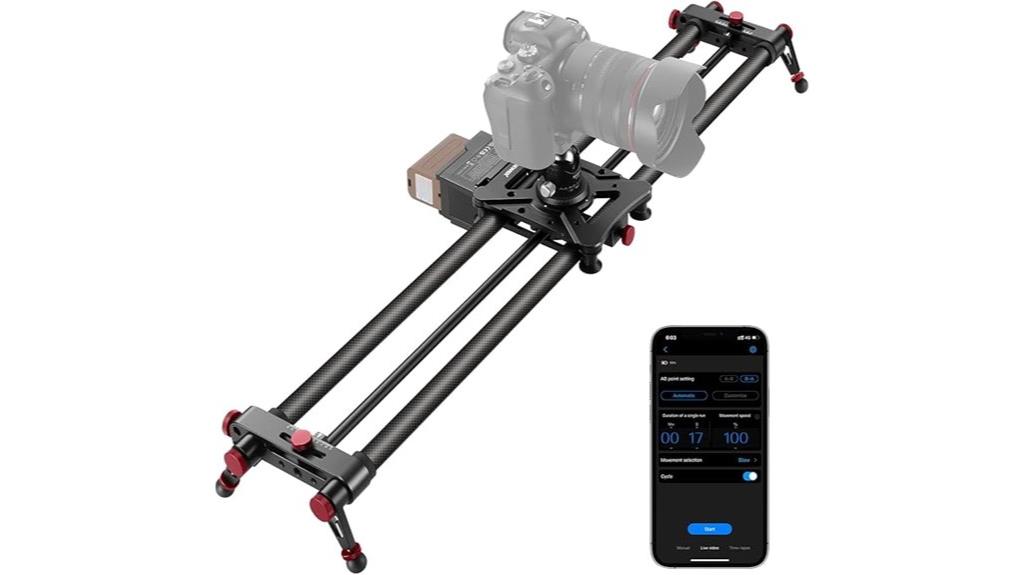
For professional videographers seeking precise and smooth camera movements, the NEEWER Motorized Camera Slider with App Control stands out thanks to its intuitive app integration. Its 31.5-inch carbon fiber build is lightweight yet sturdy, supporting various angles like horizontal, 45°, and vertical. The silent stepper motor ensures noiseless operation, ideal for high-quality footage. With dual control options—app and remote—it offers manual, video, and time-lapse modes, plus customizable settings like frame count and shutter speed. The slider’s adjustable knobs and tilt capabilities provide versatile shooting angles, making it perfect for dynamic scenes and outdoor shoots. Its rechargeable battery guarantees hours of uninterrupted use.
Best For: professional videographers and content creators seeking precise, smooth, and versatile camera movements for high-quality video production.
Pros:
- Supports multiple shooting angles including horizontal, 45°, and vertical for versatile filming.
- Quiet stepper motor ensures smooth, noiseless operation suitable for professional environments.
- Dual control options via app and remote provide flexible operation and customizable settings.
Cons:
- Battery (NP-F750) and charger are sold separately, requiring additional purchase.
- Remote control is not included, which may be inconvenient for some users.
- Limited maximum tilt at 45°, which may not suit all advanced cinematic shots.
Neewer DL400 Motorized Camera Slider Dolly with App Control

Designed for videographers seeking quiet, precise control, the Neewer DL400 Motorized Camera Slider Dolly stands out with its ultra-quiet dual motors that operate below 30dB, ensuring smooth footage without distracting noise. It features nonslip rubber wheels and handles up to 6.6lb/3kg, supporting circular, arched, and linear motions with five adjustable speeds. Controlled via the NEEWER app on iOS and Android, it offers modes like Manual, Live Video, and Time Lapse, with customizable settings for distance, speed, and direction. Powered by a rechargeable NP-F750 battery, it provides up to five hours of operation, making it a versatile tool for professional videography.
Best For: professional videographers and content creators seeking quiet, precise, and versatile camera movement solutions.
Pros:
- Ultra-quiet dual motors operate below 30dB, ensuring silent footage recording
- Supports multiple shooting modes including Manual, Live Video, and Time Lapse via app control
- Compatible with a wide range of cameras, smartphones, and accessories with adjustable motion paths and speeds
Cons:
- Limited weight capacity of 6.6lb/3kg may not suit heavier camera setups
- Requires a separate shutter cable for Time Lapse photography, adding extra equipment
- Battery life of up to 5 hours may be insufficient for extended shoots without recharging
GVM Carbon Fiber Motorized Camera Slider (48/120cm)
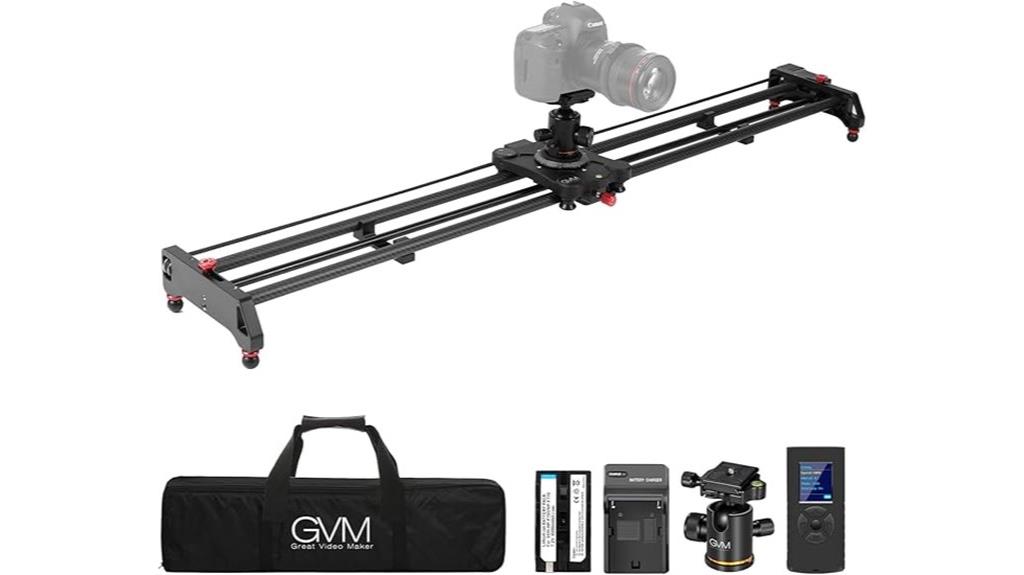
If you’re seeking a versatile slider that delivers professional results, the GVM Carbon Fiber Motorized Camera Slider (48/120cm) stands out with its multiple shooting modes and remote control capabilities. It offers video, time-lapse, horizontal, tracking, and panoramic shooting, making it highly adaptable. You can easily switch modes by adjusting the knobs or use the remote to set parameters like speed, start/end points, and shot count. Its lightweight carbon fiber build ensures durability and portability. Plus, with multiple screw ports and shutter cables, it’s compatible with various cameras and tripods. This slider provides smooth, precise control for professional-grade shots, all at your fingertips.
Best For: professional videographers and photographers seeking a versatile, portable, and precise motorized camera slider for various shooting scenarios.
Pros:
- Multiple shooting modes including video, time-lapse, panoramic, and tracking for creative flexibility
- Remote control allows for precise parameter adjustments and easy operation from a distance
- Lightweight carbon fiber construction provides durability and portability
Cons:
- Limited cable length with included shutter cables may require extensions for certain setups
- Setup and mode switching may require some familiarity with camera sliders for optimal use
- Price point might be higher compared to manual or simpler motorized sliders
GVM Motorized Camera Slider (48/120cm)
https://m.media-amazon.com/images/I/61DYSR-sM5L._AC_SX679_.jpg
The GVM Motorized Camera Slider (48/120cm) stands out with its versatile features that cater to both amateur and professional videographers seeking smooth, stable shots. It offers automatic round trips, time lapse, panoramic shooting, and customizable start and end points, making it highly adaptable. The slider’s motor allows adjustable torque, speed, and stop times, providing precise control over your shots. Built with durable carbon fiber and supported by multiple screw ports, it’s compatible with various tripods. Out of the box, it’s easy to set up, quiet during operation, and perfect for dynamic shots, stabilization, and tracking, all packaged with accessories and a portable bag for convenience.
Best For: professional videographers and serious hobbyists seeking smooth, precise camera movement for dynamic shots, time lapses, and panoramic captures.
Pros:
- Offers versatile shooting modes including auto loop, time lapse, and panoramic shots for creative flexibility.
- Made of lightweight, durable carbon fiber with adjustable features for stability and precise control.
- Comes with comprehensive accessories such as cables, remote, battery, and portable bag, ensuring convenience and ready-to-use setup.
Cons:
- May be relatively expensive compared to manual sliders, potentially limiting access for casual users.
- Requires power source and setup time, which could be inconvenient for quick shots.
- Compatibility with various tripods depends on screw port configurations, possibly limiting some setups.
Neewer 3 Wheels Wireless Video Camera Dolly

The Neewer 3 Wheels Wireless Video Camera Dolly stands out as a versatile choice for filmmakers seeking smooth, dynamic shots. Its 3-speed motorized rail offers precise control, with speeds of 1.4, 2.4, and 3.0 cm/s, adjustable via a wireless remote up to 6 meters away. The adjustable wheels can rotate up to 180°, allowing for creative circular or straight-line shots. Compatible with DSLRs, smartphones, and action cameras, it features a rechargeable 1800mAh battery providing up to 6 hours of operation. Its flexible mounting options and pitch head make it ideal for various filming angles, ensuring smooth, professional results every time.
Best For: videographers and filmmakers seeking versatile, smooth camera movement with precise control for professional and creative shots.
Pros:
- Wireless remote control with adjustable speeds up to 6 meters for flexible operation
- Adjustable wheels and pitch head for a variety of creative shooting angles
- Compatible with a wide range of devices including DSLRs, smartphones, and action cameras
Cons:
- Limited to three fixed speed settings, which may not suit all filming needs
- Battery life of up to 6 hours might require frequent recharging for extended shoots
- The adjustable wheel mechanism may require careful handling to prevent misalignment or looseness
GVM Motorized Camera Slider (48/120cm)

Designed for professional videographers and photographers, the GVM Motorized Camera Slider (48/120cm) stands out with its versatile shooting modes and customizable settings. It supports tracking, panoramic, time lapse, and video modes, allowing precise control over start/end points, motor torque, slip speed, and interval. The auto loop feature enables continuous shooting, making it highly adaptable. Built from lightweight yet durable carbon fiber, it offers stability and smooth operation. With multiple screw ports, it supports various mounting angles and tripod compatibility. Plus, the dedicated app allows remote operation via smartphones or tablets, simplifying complex shots and enhancing creative possibilities.
Best For: Professional videographers and photographers seeking versatile, customizable, and portable camera slider solutions for dynamic shooting environments.
Pros:
- Supports multiple shooting modes including tracking, panoramic, time lapse, and video, offering great creative flexibility
- Made from lightweight yet durable carbon fiber for stability and easy portability
- Features a dedicated app for remote control, simplifying operation and precise adjustments
Cons:
- Might require some setup time to master all customizable parameters and app controls
- Compatibility depends on the availability of shutter release cables for specific camera models
- The motor torque and slip speed settings may need fine-tuning for optimal performance in different conditions
IFOOTAGE Shark Slider Nano II Camera Slider with 26-Axis Pan for DJI Gimbals
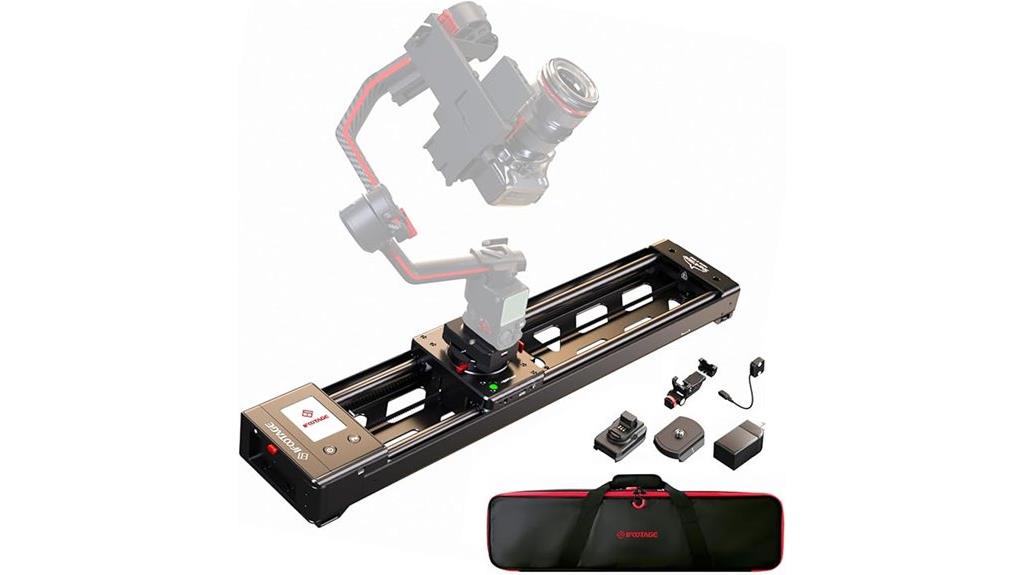
If you’re seeking a motorized slider that elevates professional filmmaking, the IFOOTAGE Shark Slider Nano II stands out with its 26-inch travel and advanced 26-axis pan system. It’s compatible with DJI RS gimbals, making it perfect for dynamic shots and smooth progressions. Its multi-axis motorized system delivers 360° unlimited rotation and dual-axis control, allowing synchronized movements and cinematic rotations. Built with aviation-grade aluminum and carbon fiber, it offers exceptional stability and ultra-quiet operation, ideal for ASMR and live events. With touchscreen control, customizable waypoints, and intelligent stabilization, it’s a versatile, reliable tool for solo creators and professionals alike.
Best For: professional filmmakers, content creators, and solo shooters seeking versatile, precise, and silent motorized camera slider solutions for dynamic filmmaking.
Pros:
- Offers 26-inch travel with advanced 26-axis pan system for versatile cinematic shots
- Compatible with DJI RS gimbals, enabling synchronized multi-axis control
- Built with durable aviation-grade aluminum and carbon fiber for stability and quiet operation
Cons:
- Requires a 60W+ power supply for USB-C PD charging, which may add to setup complexity
- May be relatively expensive for hobbyists or casual users
- Compatibility limited to specific DJI gimbal models, restricting broader gimbal use
Accsoon Toprig Motorized Camera Slider
https://m.media-amazon.com/images/I/61A44PN+i2L._AC_SY300_SX300_.jpg
For filmmakers seeking versatile and precise control, the Accsoon Toprig Motorized Camera Slider stands out with its seamless Bluetooth app integration, allowing remote adjustments and auto-calibration. Its 24/60cm electric slider supports a wide range of gear, including DSLRs, GoPro, Insta360, and smartphones (phone holder not included), with multiple mounting options thanks to standard screw holes. It offers various shooting modes like panoramic, time-lapse, and loop, along with adjustable speeds from 0.1 to 5 cm/s. Built from durable aluminum, it’s lightweight yet stable, and powered by batteries or DC input for up to 60 hours of continuous operation, ensuring professional-grade results.
Best For: professional filmmakers and videographers seeking a versatile, lightweight, and precise motorized slider compatible with various cameras and shooting modes.
Pros:
- Seamless Bluetooth app control with auto-calibration and remote operation for easy adjustments.
- Supports multiple shooting modes including panoramic, time-lapse, and loop, with adjustable speeds from 0.1 to 5 cm/s.
- Durable aluminum construction combined with a low noise brushless motor ensures smooth, stable, and quiet filming.
Cons:
- Phone holder and batteries are not included, requiring additional purchases.
- Limited maximum vertical load capacity of 2.5 kg, which may restrict heavier setups.
- The 24/60cm size may be less suitable for very large or complex camera rigs.
Rhino ROV PRO Motorized Slider for Smartphones and Small Cameras

The Rhino ROV PRO Motorized Slider stands out as an ideal choice for smartphone users and small camera enthusiasts seeking smooth, professional shots without complex setup. Its fully motorized design is controlled via your phone, making operation simple and intuitive. The built-in rechargeable battery offers up to 24 hours of continuous use, perfect for long filming sessions. You can easily create stunning time-lapses or ultra-smooth slow-motion videos, thanks to features that automatically calculate best settings. Whether capturing scenic landscapes or dynamic moments, this slider ensures stable, consistent movement, elevating your footage with minimal effort and maximum results.
Best For: smartphone and small camera users seeking smooth, professional-quality time-lapses and slow-motion videos with easy, motorized operation.
Pros:
- Fully motorized control via smartphone for effortless operation
- Long-lasting rechargeable battery supports up to 24 hours of continuous use
- Capable of capturing high-quality time-lapses and ultra-smooth slow-motion footage
Cons:
- Designed primarily for smartphones and small cameras, limiting compatibility with larger equipment
- May require a compatible smartphone with sufficient Bluetooth or Wi-Fi capabilities for optimal control
- Slightly higher price point compared to manual sliders or non-motorized options
GVM Motorized Camera Slider with APP Control
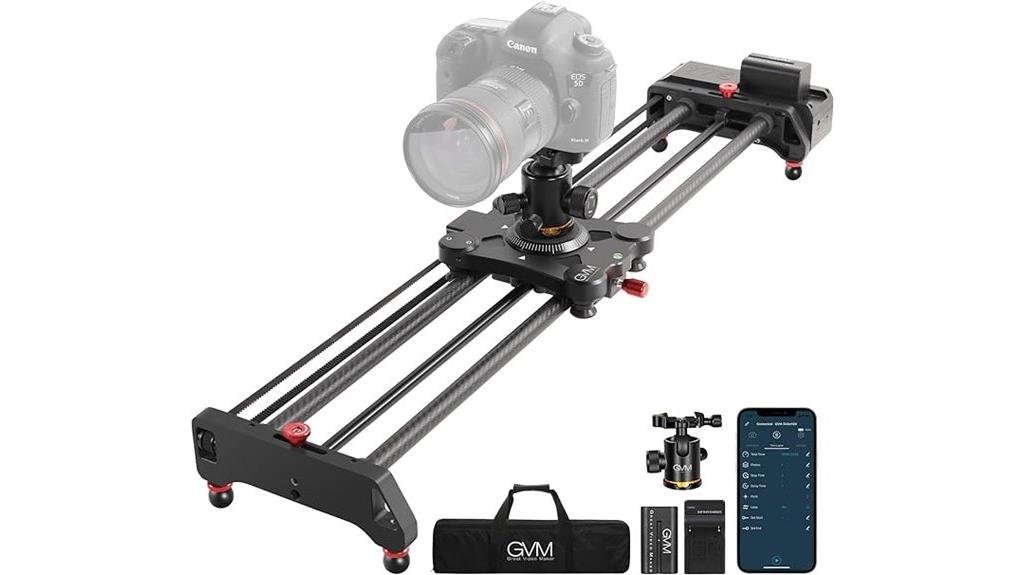
The GVM Motorized Camera Slider with APP Control stands out for its seamless wireless operation, allowing users to control shooting parameters directly from their smartphones or tablets. With support for multiple modes like tracking, panoramic, time lapse, and video, it offers extensive creative flexibility. You can set custom start and end points, adjust speed, dwell time, and sliding distance, all remotely. Its lightweight carbon fiber build guarantees stability and smooth operation, while adjustable legs help level shots on uneven surfaces. Plus, the multiple mounting options and included shutter cables make it versatile for various camera setups, making it a reliable choice for professional and hobbyist shooters alike.
Best For: hobbyist and professional photographers seeking a lightweight, versatile, and remotely controllable motorized slider for diverse shooting scenarios.
Pros:
- Supports multiple shooting modes including tracking, panoramic, and time lapse for creative flexibility
- Wireless APP control compatible with iOS and Android for convenient remote operation
- Made from durable carbon fiber, ensuring stability, lightweight portability, and smooth operation
Cons:
- Requires compatible smartphones or tablets for wireless control, potentially limiting use without devices
- Multiple shutter cables may be needed for diverse camera models, adding to setup complexity
- Limited to specific mounting options and angles, which may restrict certain unconventional shooting angles
Motorized Camera Slider with Dual Control and Power Supply

A motorized camera slider with dual control and a reliable power supply is essential for filmmakers and content creators aiming for smooth, professional shots without interruptions. I appreciate how this slider from Zecti offers both button and app control, giving me flexibility during shoots. Its high-precision motor and soft start/stop ensure quiet, seamless motion, while the durable double tube construction guarantees stability. The included power supply keeps me going without worries about battery life. Whether I’m doing live recording, time-lapse, or stop motion, this setup supports various scenarios. It’s a dependable tool that enhances my creative possibilities with consistent, smooth movements.
Best For: content creators, filmmakers, and photographers seeking smooth, professional camera movements for various shooting scenarios.
Pros:
- Dual control options via button and app for flexible operation
- Smooth, noiseless sliding with high-precision motor and durable construction
- Compatible with a wide range of cameras and accessories, supporting diverse shooting modes
Cons:
- May require additional extension cables for longer camera setups
- Heavier or bulkier compared to manual sliders, affecting portability
- Dependence on compatible devices and apps, which may need updates or troubleshooting
Accsoon Toprig 16-inch Motorized Camera Slider
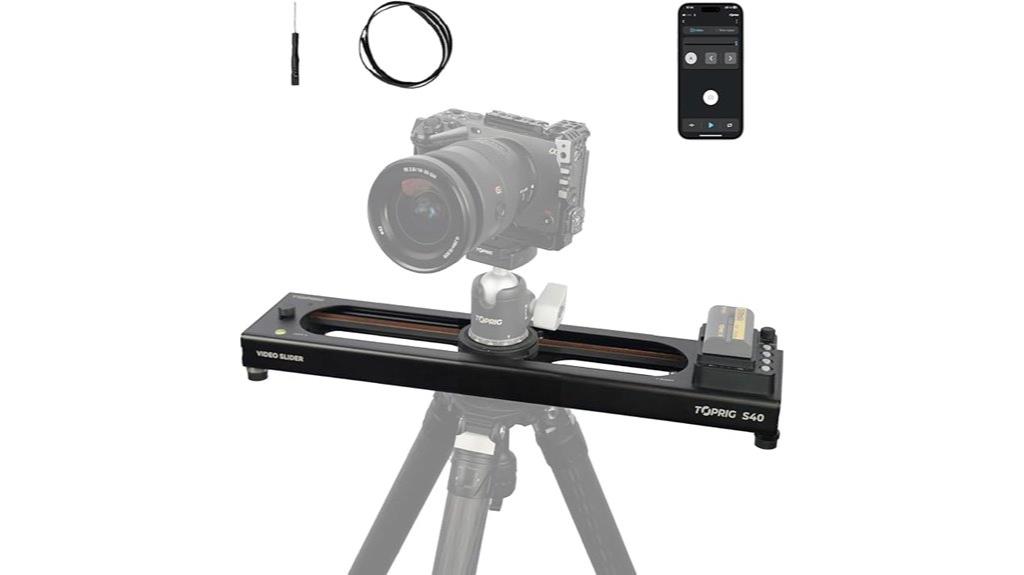
Designed for both amateur and professional videographers, the Accsoon Toprig 16-inch Motorized Camera Slider stands out with its dual control options, allowing seamless switching between manual operation and Bluetooth app control. I appreciate how the Toprig app offers features like time-lapse, loop, and programmable moves, making creative shots easier. The speed knob lets me fine-tune movement from 0.1 to 5 cm/s. Made from durable aluminum, it’s lightweight yet stable, supporting various cameras up to 4 kg. The ultra-silent brushless motor keeps noise below 30 dB, ensuring quiet shoots. Overall, it’s a versatile, reliable slider that delivers smooth footage with flexible control options.
Best For: amateur and professional videographers seeking a versatile, quiet, and easy-to-control motorized camera slider for smooth cinematic shots.
Pros:
- Sturdy construction with lightweight aluminum alloy for portability and stability
- Multiple control options including manual and Bluetooth app control with features like time-lapse and programmable moves
- Ultra-silent brushless motor producing noise below 30 dB, ideal for professional video production
Cons:
- Battery and power supply are not included, requiring additional purchase
- Limited usable range at slider ends due to jitter or jittering issues
- Some users experience setup difficulties or connectivity issues with the app
Factors to Consider When Choosing Motorized Camera Sliders
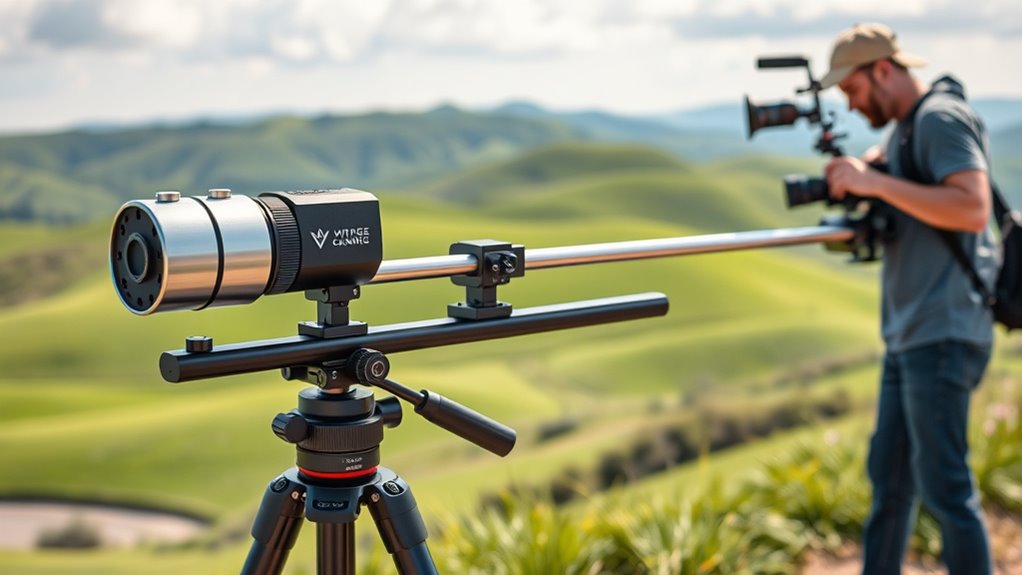
When selecting a motorized camera slider, I focus on key factors like movement precision, camera compatibility, and durability. I also consider control options and power sources to guarantee flexibility during shoots. Understanding these points helps me choose a slider that meets my filming needs efficiently.
Motorized Movement Precision
Achieving smooth, consistent shots hinges on the precision of a motorized slider’s movement, making it a crucial factor to contemplate. High-precision motors, like stepper or brushless types, can deliver accuracy within 0.01mm, ensuring fluid motion. Micro-stepping technology further refines control, allowing for finer adjustments and smoother transitions. Advanced firmware algorithms are essential for minimizing backlash, jitter, and overshoot, maintaining steady movement. Stable power supplies prevent voltage fluctuations that could affect performance, keeping shots consistent. Additionally, integrating feedback sensors or encoders provides real-time data, enabling the system to correct any deviations immediately. All these elements work together to deliver the precise, reliable motion necessary for professional-quality footage, making movement accuracy a top priority when selecting a motorized slider.
Compatibility With Cameras
Choosing the right motorized slider involves making certain it works seamlessly with your camera setup. First, check that the slider has compatible screw threads—either 1/4” or 3/8”—to fit your camera or mounting accessories. Next, verify the maximum load capacity, making sure it can support your camera and gear without strain. It’s also important to confirm the slider supports your camera type, whether it’s DSLR, mirrorless, smartphone, action camera, or camcorder. Additionally, consider the control options available—app, remote, or manual—and ensure they’re compatible with your device’s operating system like iOS or Android. Finally, review the power supply and connection ports to see if they match your camera’s power needs. These factors help ensure smooth, hassle-free operation.
Build Material Durability
The build material of a motorized camera slider plays a crucial role in determining its durability and performance. High-quality metals like aluminum alloy and carbon fiber stand out because they offer excellent strength and longevity. Aluminum alloy sliders are lightweight, resistant to corrosion, and impact-proof, making them ideal for outdoor shoots and rough handling. Carbon fiber, on the other hand, provides an exceptional strength-to-weight ratio, ensuring durability without adding bulk. The choice of material directly influences resistance to wear and tear, especially with frequent use or transportation. Proper manufacturing processes and finishes are equally important, as they minimize risks of cracks, deformation, or mechanical failure over time. Selecting a slider with durable build materials guarantees reliable performance and a longer lifespan.
Control Options Availability
Selecting the right control options for a motorized camera slider depends on how you plan to shoot and your level of experience. I consider whether I need simple operation or advanced features. Physical buttons are straightforward, perfect for quick adjustments, but they lack programmability for complex shots. Remote controls offer more flexibility with speed adjustments and direction changes, yet they usually don’t support detailed programming. Smartphone apps are the most versatile, allowing me to set precise motion paths, adjustable speeds, and start/end points, which enhances creativity and automation. The choice impacts how easily I can execute complex shots and how much control I have over the filming process. Ultimately, it’s about balancing ease of use with the level of precision and automation I require for my projects.
Power Source Flexibility
A flexible power source setup is essential for ensuring my motorized slider keeps running smoothly in any environment. I look for models that support multiple power options, like rechargeable batteries, USB power banks, or direct AC/DC adapters, so I can adapt to different shooting situations. Battery compatibility and runtime are vital—long-lasting batteries mean I can shoot for hours without interruptions. The ability to easily switch between power sources, such as swapping batteries or connecting external supplies, minimizes downtime. I also check for support of standard connectors like USB Type-C or DC ports that work with common chargers. Safety features like overcharge protection and low-battery indicators are important, as they prevent failures and keep my shoots reliable and stress-free.
Size and Portability
When choosing a motorized slider, size and portability play crucial roles in guaranteeing it fits seamlessly into my shooting setup. Smaller sliders under 36 inches are easier to carry and perfect for on-the-go shoots, while longer ones, like 48 inches or more, offer more travel but tend to be bulkier and heavier. Foldable or modular designs boost portability by making storage and transportation simpler. Weighing less than 10 pounds, lightweight sliders are ideal for outdoor shoots and quick setups, but heavier models provide increased stability. I also consider the overall dimensions and weight capacity to guarantee the slider comfortably supports my camera gear and fits my carrying method. Balancing size, weight, and portability helps me select a slider suited to my shooting environment.
Shooting Mode Versatility
Size and portability are key factors, but the true power of a motorized slider lies in its shooting mode versatility. A versatile slider supports multiple modes like time-lapse, video, panoramic, and tracking shots, helping me adapt to various creative needs. Adjustable settings such as slip speed, interval, stop time, and photo count give me precise control over motion, whether I want slow, sweeping movements or quick changes. The ability to set custom start and end points, along with auto-looping and cycling, makes seamless, professional sequences possible. Compatibility with apps and remote controls allows for flexible operation and complex shot planning. Supporting multiple angles—horizontal, vertical, or 45°—further broadens my creative options, ensuring I can craft dynamic, diverse shots effortlessly.
Noise Level Management
Choosing a motorized slider with a low noise level is essential for maintaining professional-quality audio during filming. A quiet motor, ideally below 30dB, prevents unwanted noise from interfering with your recordings. Brushless motors are preferable because they produce less sound than brushed motors, ensuring silent operation. Keep in mind that noise levels can vary depending on the speed; higher speeds typically generate more noise, so consider your filming needs carefully. Product descriptions often specify decibel ratings—aim for sliders with low ratings to minimize disturbance. Additionally, you can manage noise further by mounting the slider on vibration-dampening surfaces or using external soundproofing techniques. Prioritizing noise level management ensures cleaner audio and a more professional final product.
Frequently Asked Questions
How Do Motorized Sliders Handle Uneven Terrain During Outdoor Shoots?
Motorized sliders handle uneven terrain pretty well thanks to built-in leveling features and adjustable legs. I always check for models with rubberized feet or ball heads to keep stability. When I shoot outdoors, I make sure to set up on as flat a surface as possible, and I use additional support like sandbags if needed. This way, I guarantee smooth, steady shots even on tricky terrain.
Can These Sliders Be Integrated With Existing Camera Stabilization Systems?
Yes, I can integrate motorized sliders with existing stabilization systems. I usually check compatibility first, ensuring the slider’s control system can sync with my stabilizer, like a gimbal or steadicam. Then, I use remote controls or app integrations to coordinate movements. This setup gives me smooth, professional shots without extra effort, making my outdoor shoots more dynamic and polished.
What Are the Maintenance Requirements for Long-Term Durability?
Keep your gear in top shape, and it’ll serve you well for ages. I recommend regular cleaning of the rails and motor parts to prevent dust buildup, plus lubrication every few months to keep everything smooth. Check the motor’s connections and firmware updates periodically. If you stay on top of maintenance, your slider will run like clockwork, making sure your shots stay silky and professional long-term.
Are There Specific Power Sources Recommended for Extended Shooting Sessions?
For extended shooting sessions, I recommend using a reliable power source like an AC adapter or high-capacity rechargeable batteries. I prefer AC power when possible, as it provides continuous, uninterrupted energy, but I keep extra batteries on hand for portability. Lithium-ion batteries are my go-to due to their longevity and quick recharge times. Always guarantee your power source matches the slider’s requirements to avoid damage and ensure smooth operation.
How Do I Choose the Right Slider Length for Different Filming Scenarios?
Imagine your shot as a story, and the slider length as the chapter. I choose shorter sliders for tight spaces or dynamic handheld shots, while longer ones are perfect for sweeping landscapes or cinematic sequences. Consider your filming environment and subject distance—if you’re capturing wide scenes, go longer. For detail shots or confined areas, a shorter slider keeps things manageable. Tailor the length to match your creative vision and scene requirements.
Conclusion
So, there you have it—your ticket to cinematic perfection or at least a convincing imitation. Whether you prefer sleek aluminum, carbon fiber, or app-controlled magic, these sliders promise smooth shots without breaking the bank or your spirit. Just remember, no slider can turn a bad scene into a masterpiece—so don’t blame the gear if your footage still looks like a shaky camping trip. Happy shooting, and may your shots be as smooth as your coffee!
